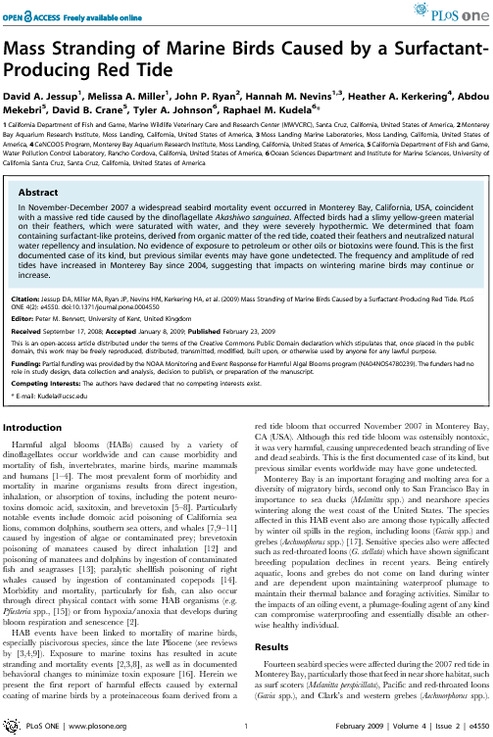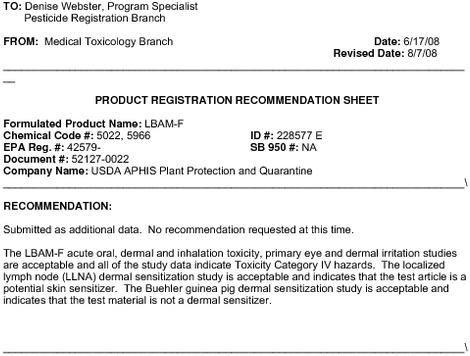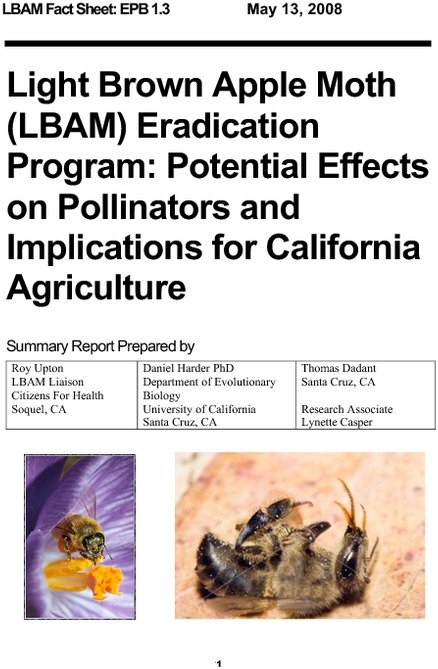From the Open-Publishing Calendar
From the Open-Publishing Newswire
Indybay Feature
California
Santa Cruz Indymedia
Environment & Forest Defense
Government & Elections
Health, Housing & Public Services
New State Study Supports Concerns About Aerial Pesticide Spray; More Questions Remain
Santa Cruz, CA. February 27, 2009. A report, released last week and authored by a group of researchers from various organizations supports concerns Californians have had about the aerial spraying of pesticides in the Monterey Bay area in 2007. The study clearly shows the correlation of the unprecedented bird die off and red tide with the timing of the spraying of the pesticide Checkmate. Other questions remain unanswered.
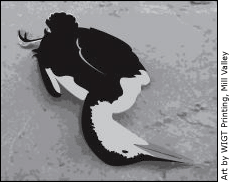
New State Study Supports Californians' Concerns About Aerial Pesticide Spray; More Questions Unanswered
Santa Cruz, CA. February 27, 2009. A report, released last week and authored by a group of researchers from various organizations including the University of California Santa Cruz (UCSC), California Department of Fish and Game, and Monterey Bay Aquarium Research Institute, Moss Landing, supports concerns Californians have had about the aerial spraying of pesticides in the Monterey Bay area in 2007.
The study clearly shows the correlation of the unprecedented bird die off with the timing of the spraying of the pesticide Checkmate.
The authors of the study reported the birds had a "slimy yellow-green material on their feathers" and that the cause of death was due to "surfactant-like proteins, derived from organic matter of the red tide, [that] coated their feathers and neutralized natural water repellency and insulation." The birds were unable to maintain buoyancy and drowned.
While the researches commented on the foam as being attributed to red tide, the foam was in fact also seen in rivers after the pesticide spraying, and found by a San Jose State University researcher to be filled with microcapsules associated with the spray. Many residents within the spray zone remember the yellowish foamy substance on their windows, decks, and planter boxes left by the spray.
Former Santa Cruz city council member Ed Porter recalls thick yellow foam covering the San Lorenzo River: "I went to the trestle bridge and found a great deal of foam over about 3/4 of the width of the river. It was about 5 inches thick in some places. This is a spot on the river I visit often and I have never in 40 years seen foam like this there or anywhere else on the river. I saw the foam also all along the cliff at Cowells Beach which is the Northern reach of Monterey Bay."
According to Capitola resident Jacquie Rainwater, who together with her teenage daughter helped in the rescue of the sea birds: "We found the birds washing up in droves, soaking wet, shivering and frightened. There were grebes, loons, and scooters, literally drowning in front of our eyes. They were unable to make it all the way to shore, so they just sank. It was awful to watch."
Not studied by the investigators was the potential synergism between the highly toxic surfactant agent tricaprly methylamonnium chloride (TMAC), present in Checkmate, and the surfactant protein found to be the cause of the bird deaths.
The authors note in their study that this was the first documented severe red tide capable of producing such a foam. The red tide coincided with the first time Checkmate was aerially sprayed in the vicinity of a national marine sanctuary. After the spraying, pesticide drift was measured over a distance of more than three miles, violating buffer zones around the sanctuary.
The pesticide label clearly states that the compound should not be used or come in contact with water.
The study also did not mention that Checkmate contains several compounds that can feed the microplankton that gives rise to red tide, including several surfactants, phosphates and urea.
Veteran surfers who have been surfing in the Monterey Bay for decades commented on the unique severity of the red tide that spiked after the spraying of Checkmate.
The study additionally noted that "some birds showed gross or microscopic evidence of acute haemorrhage into the lungs [...]" and adds that "one important possibility that merits investigation is exposure to an aerosolized component of the surface slime."
The study's findings fit with other research sponsored by the state of California: results of acute toxicology tests for Checkmate, released by the state in November 2008, showed that one out of ten lab animals died after only four hours of dermal exposure. Necropsy results showed "pale lungs" among other organ abnormalities.
These findings are echoed in the new study, where necropsy of the birds revealed that "... approximately half of the birds had gross and/or microscopic evidence of acute haemorrhage into the pulmonary parabronchi and adjacent pulmonary parenchyma was sometimes pale and hypoperfused."
These findings are consistent with the American Lung Association who reports that exposure to aerosol particulate matter of 10 microns can cause respiratory distress, emphysema, and even death. This connection was also not mentioned in the study.
Finally, the authors added: "Of note, some animal care personnel also reported mild respiratory irritation after contact with heavily soiled birds during this event."
Respiratory distress, from mild to almost lethal, was the most reported symptom due to the spraying and the aforementioned toxicology tests have shown Checkmate to be an irritant.
The sea bird-die off, the most severe ever reported for the Santa Cruz area, occurred immediately after three days of all-night pesticide spraying of residential areas by the California Department of Food and Agriculture (CDFA) in attempts to eradicate the Light Brown Apple Moth (LBAM), a moth that experts say has been in California for decades and is now known to not pose a threat to agriculture or native plants.
The bird die off dissipated in approximately 30 days which correlates with the life span of the microcapsules associated with the pesticide spray.
Download the bird study, toxicology tests on Checkmate, and a review of the temporal association between the bird die-off and the aerial spray at http://www.stopthespray.org/lbam/
###
Santa Cruz, CA. February 27, 2009. A report, released last week and authored by a group of researchers from various organizations including the University of California Santa Cruz (UCSC), California Department of Fish and Game, and Monterey Bay Aquarium Research Institute, Moss Landing, supports concerns Californians have had about the aerial spraying of pesticides in the Monterey Bay area in 2007.
The study clearly shows the correlation of the unprecedented bird die off with the timing of the spraying of the pesticide Checkmate.
The authors of the study reported the birds had a "slimy yellow-green material on their feathers" and that the cause of death was due to "surfactant-like proteins, derived from organic matter of the red tide, [that] coated their feathers and neutralized natural water repellency and insulation." The birds were unable to maintain buoyancy and drowned.
While the researches commented on the foam as being attributed to red tide, the foam was in fact also seen in rivers after the pesticide spraying, and found by a San Jose State University researcher to be filled with microcapsules associated with the spray. Many residents within the spray zone remember the yellowish foamy substance on their windows, decks, and planter boxes left by the spray.
Former Santa Cruz city council member Ed Porter recalls thick yellow foam covering the San Lorenzo River: "I went to the trestle bridge and found a great deal of foam over about 3/4 of the width of the river. It was about 5 inches thick in some places. This is a spot on the river I visit often and I have never in 40 years seen foam like this there or anywhere else on the river. I saw the foam also all along the cliff at Cowells Beach which is the Northern reach of Monterey Bay."
According to Capitola resident Jacquie Rainwater, who together with her teenage daughter helped in the rescue of the sea birds: "We found the birds washing up in droves, soaking wet, shivering and frightened. There were grebes, loons, and scooters, literally drowning in front of our eyes. They were unable to make it all the way to shore, so they just sank. It was awful to watch."
Not studied by the investigators was the potential synergism between the highly toxic surfactant agent tricaprly methylamonnium chloride (TMAC), present in Checkmate, and the surfactant protein found to be the cause of the bird deaths.
The authors note in their study that this was the first documented severe red tide capable of producing such a foam. The red tide coincided with the first time Checkmate was aerially sprayed in the vicinity of a national marine sanctuary. After the spraying, pesticide drift was measured over a distance of more than three miles, violating buffer zones around the sanctuary.
The pesticide label clearly states that the compound should not be used or come in contact with water.
The study also did not mention that Checkmate contains several compounds that can feed the microplankton that gives rise to red tide, including several surfactants, phosphates and urea.
Veteran surfers who have been surfing in the Monterey Bay for decades commented on the unique severity of the red tide that spiked after the spraying of Checkmate.
The study additionally noted that "some birds showed gross or microscopic evidence of acute haemorrhage into the lungs [...]" and adds that "one important possibility that merits investigation is exposure to an aerosolized component of the surface slime."
The study's findings fit with other research sponsored by the state of California: results of acute toxicology tests for Checkmate, released by the state in November 2008, showed that one out of ten lab animals died after only four hours of dermal exposure. Necropsy results showed "pale lungs" among other organ abnormalities.
These findings are echoed in the new study, where necropsy of the birds revealed that "... approximately half of the birds had gross and/or microscopic evidence of acute haemorrhage into the pulmonary parabronchi and adjacent pulmonary parenchyma was sometimes pale and hypoperfused."
These findings are consistent with the American Lung Association who reports that exposure to aerosol particulate matter of 10 microns can cause respiratory distress, emphysema, and even death. This connection was also not mentioned in the study.
Finally, the authors added: "Of note, some animal care personnel also reported mild respiratory irritation after contact with heavily soiled birds during this event."
Respiratory distress, from mild to almost lethal, was the most reported symptom due to the spraying and the aforementioned toxicology tests have shown Checkmate to be an irritant.
The sea bird-die off, the most severe ever reported for the Santa Cruz area, occurred immediately after three days of all-night pesticide spraying of residential areas by the California Department of Food and Agriculture (CDFA) in attempts to eradicate the Light Brown Apple Moth (LBAM), a moth that experts say has been in California for decades and is now known to not pose a threat to agriculture or native plants.
The bird die off dissipated in approximately 30 days which correlates with the life span of the microcapsules associated with the pesticide spray.
Download the bird study, toxicology tests on Checkmate, and a review of the temporal association between the bird die-off and the aerial spray at http://www.stopthespray.org/lbam/
###
Add Your Comments
Comments
(Hide Comments)
In November-December 2007 a widespread seabird mortality event occurred in Monterey Bay, California, USA, coincident with a massive red tide caused by the dinoflagellate Akashiwo sanguinea. Affected birds had a slimy yellow-green material on their feathers, which were saturated with water, and they were severely hypothermic. We determined that foam containing surfactant-like proteins, derived from organic matter of the red tide, coated their feathers and neutralized natural water repellency and insulation. No evidence of exposure to petroleum or other oils or biotoxins were found. This is the first documented case of its kind, but previous similar events may have gone undetected. The frequency and amplitude of red tides have increased in Monterey Bay since 2004, suggesting that impacts on wintering marine birds may continue or increase.
For more information:
http://www.plosone.org/article/info%3Adoi%...
For more information:
http://forum.stopthespray.org/viewtopic.ph...
For more information:
http://forum.stopthespray.org/viewtopic.ph...
This story misrepresents the research findings. After extensive work the researchers explicitly ruled out the LBAM spray as a cause of the bird die-offs. The die-offs were caused by a dinoflagellate bloom. Such blooms are not uncommon in the late fall. It is possible that runoff or groundwater from land helped start the bloom, but we have little conclusive evidence on this. To say that the LBAM spraying created the bloom is completely unfounded.
WRONG !!! The chemistry labs looked for the active ingredient in Checkmate. It wasn't there. The spherules in the gross LBAM product were not on the birds. Similar marine birds stranded and were picked up on the two days BEFORE the spraying. Lab cultures of Akashiwo produced less of the fouling foam if "checkmate" was added. The LBAM spray product has about the same amount of urea and phosphate as Miracle Grow, which is used by the ton in this same area. The rains after the spray to too light to cause the major creeks and steams to break their sand berm levies, so the Pajaro didn't even empty into the ocean after the spray. What this paper and other work done by these researchers shows it that there is NO evidence that spraying had anything to do with the bird mortality event.
The yellow foam/gunk that was found in the ocean that the researchers determined killed the birds was also found inland away from the ocean immediately after the spray. It covered home patios, awnings and so many surfaces inland. When it rained, much of the yellow gunk from the aerial spray washed into the ocean and killed the birds in its reaction with the red tide, but it is the yellow gunk that came from the aerial spray that caused the problem.
The CDFA wants $500 million of taxpayer emergency funds over 5 years so they will lie and say anything. The moth has never on this earth been a significant pest and there is no damage from this moth in California, none. Two Superior Courts found NO damage, even though CDFA wanted the people to believe there was. CDFA said they would appeal the decision, but they quietly slipped away and WITHDREW their appeal. It doesn't matter how many LBAM CDFA reports they found. The moth doesn't do damage in California or in New Zealand or in any other place on this earth where it lives. The CDFA wants to receive the money, and give most of it to their insider crony buddies who own the chemical company with the contract from the state.
Pay attention. If you still think that LBAM is dangerous. Try to remember WHY you think that. Simply cause CDFA said so over and over and over again. If LBAM were dangerous, you'd be able to find a place that LBAM devastated a forest or farm or backyard garden. There is no such place on this earth at any time in recorded history. CDFA is lying. 32 Cities and counties passed resolutions against the CDFA program. Each of them simply did sufficient research to determine that LBAM was not a threat to agriculture or forests. Its that simple. Please do two hours of research. Call a farmer in New Zealand. He will laugh about LBAM, the same way you would laugh if someone asked you if lady bugs are dangerous. CDFA is lying, CDFA is lying, CDFA is lying. And one more thing: CDFA is lying. ...go make your phone call (or 100 calls) and find out for yourself.
The CDFA wants $500 million of taxpayer emergency funds over 5 years so they will lie and say anything. The moth has never on this earth been a significant pest and there is no damage from this moth in California, none. Two Superior Courts found NO damage, even though CDFA wanted the people to believe there was. CDFA said they would appeal the decision, but they quietly slipped away and WITHDREW their appeal. It doesn't matter how many LBAM CDFA reports they found. The moth doesn't do damage in California or in New Zealand or in any other place on this earth where it lives. The CDFA wants to receive the money, and give most of it to their insider crony buddies who own the chemical company with the contract from the state.
Pay attention. If you still think that LBAM is dangerous. Try to remember WHY you think that. Simply cause CDFA said so over and over and over again. If LBAM were dangerous, you'd be able to find a place that LBAM devastated a forest or farm or backyard garden. There is no such place on this earth at any time in recorded history. CDFA is lying. 32 Cities and counties passed resolutions against the CDFA program. Each of them simply did sufficient research to determine that LBAM was not a threat to agriculture or forests. Its that simple. Please do two hours of research. Call a farmer in New Zealand. He will laugh about LBAM, the same way you would laugh if someone asked you if lady bugs are dangerous. CDFA is lying, CDFA is lying, CDFA is lying. And one more thing: CDFA is lying. ...go make your phone call (or 100 calls) and find out for yourself.
With all that we have learned over the past 8 years why would you ever trust the government to tell the truth?
When you evaluate who is behind a scheme or a crime the first thing you have to ask your self is:
Who will gain from this? Who stands to benifit?
Then ask yourself what does that single mother gain from protesting the spray? Then ask 'what does that state agency stand to gain?' - Could it be that mulit million dollar funding from homeland security? Could the director for the Department of Fish and Game get fired if they show a negitive side effect of the spray?
Why does the company who makes the biochemical pesitcide claim that there are no bad side effects of the spray then obtain a court order to seal the records that show the ingreidant and how bad they are?
Behind every crime you must always ask who stands to gain?
It is standrad logical reasoning.
When you evaluate who is behind a scheme or a crime the first thing you have to ask your self is:
Who will gain from this? Who stands to benifit?
Then ask yourself what does that single mother gain from protesting the spray? Then ask 'what does that state agency stand to gain?' - Could it be that mulit million dollar funding from homeland security? Could the director for the Department of Fish and Game get fired if they show a negitive side effect of the spray?
Why does the company who makes the biochemical pesitcide claim that there are no bad side effects of the spray then obtain a court order to seal the records that show the ingreidant and how bad they are?
Behind every crime you must always ask who stands to gain?
It is standrad logical reasoning.
Don't listen to the companies propaganda, it is a known fact that all pesticides and herbicides are poisonous and kill, and that is the reason they are sprayed. The choice of the skull and crossbones on the containers is not there for the point of joyous art work. It is to warn you away from poisoning yourself or your family, friends, and the people and living biengs in the area or neighbourhood that you live in. Of course poison spraying kills the birds and the bees. Best we all go back to natures laws ol organic matter and organic ways of looking after the plants, animals, and peoples that we know live around us. That is true to the living world.
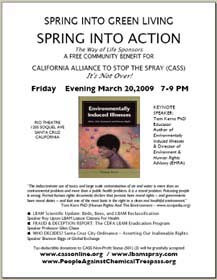
Key Note Speaker: Tom Kerns, PhD, International Expert on Human Rights Violations regarding Aerial Spraying. Tom Kerns' recent report for CASS lists 23 Human Right Violations and site the actual codes that are violated by aerial spraying.
Tom Kerns' is also author of Environmentally Induced Illnesses: Ethics, Risk Assessment and Human Rights
Event Flyer
http://www.lbamspray.com/00_Flyers/SPRINGINTOACTIONposter2009.pdf
Tom Kerns' is also author of Environmentally Induced Illnesses: Ethics, Risk Assessment and Human Rights
Event Flyer
http://www.lbamspray.com/00_Flyers/SPRINGINTOACTIONposter2009.pdf
For more information:
http://cassonline.org/
We are 100% volunteer and depend on your participation to sustain our efforts!
Get Involved
If you'd like to help with maintaining or developing the website, contact us.
Publish
Publish your stories and upcoming events on Indybay.
Topics
More
Search Indybay's Archives
Advanced Search
►
▼
IMC Network


